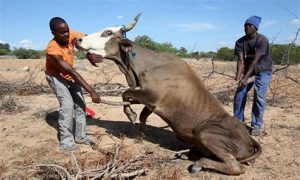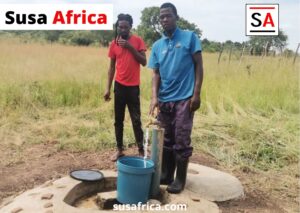Zimbabwe’s average rainfall is 250 millimetres a year, but that’s what they have had in five years where average temperatures are rising twice as fast as the global mean, has suffered from a significant lack of rain.
The entire southern tip of the African continent drought has added to a long list of crises, from shortages of cash, petrol, medicines, water and electricity.
 The entire southern tip of the African continent drought has added to a long list of crises, from shortages of cash, petrol, medicines, water and electricity.
The entire southern tip of the African continent drought has added to a long list of crises, from shortages of cash, petrol, medicines, water and electricity.
The United Nations says a record 45 million people in southern Africa face hunger amid a “silent catastrophe” caused by repeated drought, widespread flooding and economic chaos.
The growing water shortage is compounding the countless sufferings with which Zimbabweans are fighting which includes foundering economy, increasing inflation, mounting food insecurity, and a deeply compromised public health care structure. Scarcities of hygienic, cheap water loom individual and communal health in the distressed Southern African state. Meanwhile, some major urban centres have also not been spared by the devastating drought, particularly those in the southern parts of the country. The chronic lack of rain is threatening mass hunger and ruin.
Meanwhile, some major urban centres have also not been spared by the devastating drought, particularly those in the southern parts of the country. The chronic lack of rain is threatening mass hunger and ruin.
The climate is being fingered as the biggest culprit. Even before the drought struck, water shortages were common in Zimbabwe’s capital due to decrepit infrastructure and chemical shortages. Harare also faces chronic water shortages due to aging pipes and a shortage of dollars to import treatment chemicals.
However, other cities facing serious water shortages are Bulawayo and Gweru where some of the main supply dams ran dry last year, forcing the local authorities to ration water.
The municipality takes in only 15 million Zimbabwean dollars in revenue each month. In September, Harare deputy mayor Enock Mupamawonde called on the government to declare the water shortage a national disaster, saying the local authority needs at least 40 million Zimbabwean dollars ($2m) a month for water chemicals.
Nyamandlovu aquifer was developed in 1996 to improve water supply for Bulawayo but the city has continued to experience water shortage. The crisis has seen council effecting a 96-hour weekly water shedding programme as part of measures to save the resource. Water supply and sanitation in Zimbabwe is defined by many small scale successful programs but also by a general lack of improved water and sanitation systems for the majority of Zimbabwe.
Water supply and sanitation in Zimbabwe is defined by many small scale successful programs but also by a general lack of improved water and sanitation systems for the majority of Zimbabwe.
There are also concerns over how the water crisis is affecting the social fabric of the area. Fresh vegetables are hard to come by because water is so scarce. The region’s temperatures is spurring the need for innovative ideas to get food on tables.
Water supply and sanitation in Zimbabwe is defined by many small scale successful programs, but also by a general lack of improved water and sanitation systems for the majority of Zimbabweans.
There are also concerns over how the water crisis is affecting the social fabric of the area. Fresh vegetables are hard to come by because water is so scarce. The region’s temperatures is spurring the need for innovative ideas to get food on tables.



















Be First to Comment